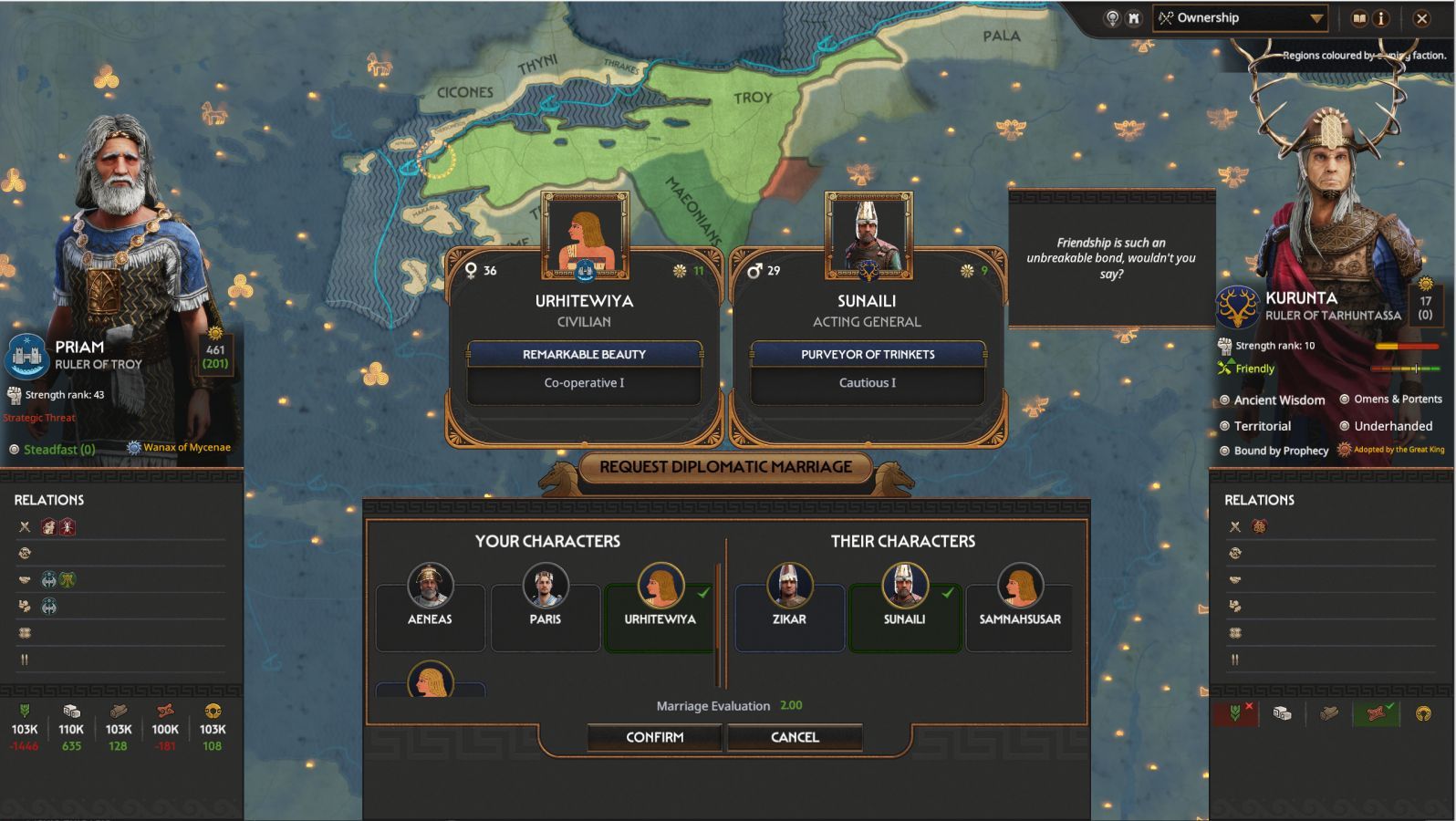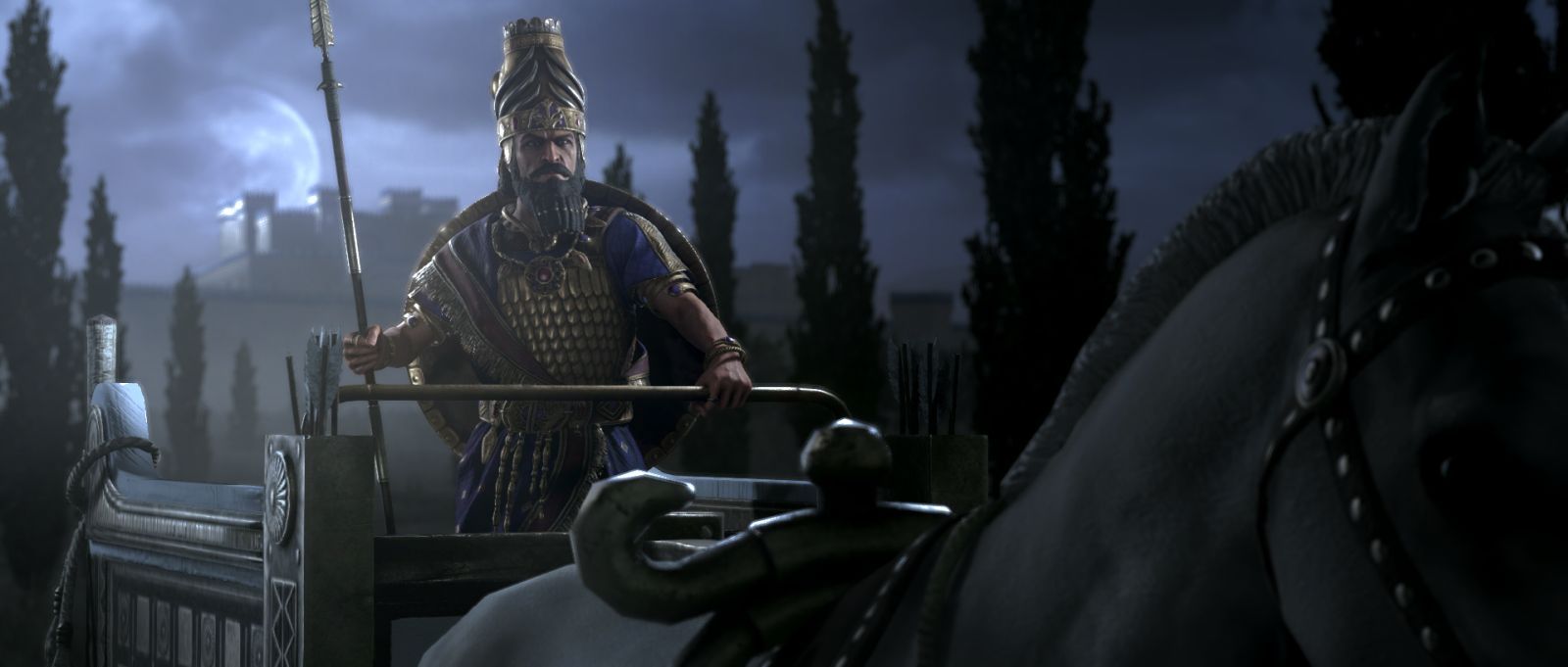Total War: Pharaoh Dynasties adds a plethora of new content to Total War: Pharaoh. This content completely changes the game. My review treats Total War: Pharaoh Dynasties as a brand-new game because that’s what it feels like when you play. I didn’t get much time with the base game, but from what I got to play, it never clicked with me the same way Total War: Three Kingdoms, Warhammer II, and Troy did. I am happy that Total War: Pharaoh Dynasties made me fall in love with this installment in the Total War franchise.
I only played Total War: Pharaoh Dynasties on my Steam Deck. I capped everything at 30FPS and was more than happy with my experience. During each of my playthroughs, I got around two hours of playtime.
What’s New?
The map now includes Greece and Mesopotamia, and seeing it in the game made my jaw drop. It’s the best-looking Total War map I’ve seen yet. There are also four new playable cultures; Babylon, Assyria, Mycenae, and Troy. On top of that, you’re getting 25 minor factions and 4 new ancient legacy mechanics.

For me, the highlight of Total War: Pharaoh Dynasties is the brand new dynasty system that focuses on your lineage. There were tons of updates to existing systems and much more.
There are new landmark buildings. I haven’t found them all yet. The Sea People had a complete overhaul of how they moved on the map. They have a flow that is more organic and will attempt to conquer territories and actively expand across the map.
There are tons of new campaign options. You can now start by selecting any Ancient Legacy. You can also select any Royal Power and Shuffle Commands. You can adjust how Lethal Blows work and if you want Character Mortality on. You can tweak the general XP gain and adjust the seasons. Finally, you can change the Turns Per Year.
Battle Changes
Over 80 new units were added to the Mesopotamian roster. The developers have reworked over 70 units from Mycenae, Troy, and Thrace to fit into Total War: Pharaoh.
My favorite part of the battle changes is the cavalry options for the horses and camels. I have to say the animations for the camels especially make me happy when I see them on the battlefield.
There were significant changes to allow for better charges and engagements. The charges are more lethal and feel extremely fluid on the battlefield. Realistic missile trajectories, enhanced visibility, and lethality settings were also added.
Total War: Pharaoh Dynasties has my favorite battle mechanics in any Total War game. The changes to how battles work make the game come alive. Most of these changes make battling feel more realistic, and I love seeing how each change happens in real-time on the battlefield.
I love the new lethality stat: This stat gives a percentage to kill an enemy in one successful hit. I find this to be realistic and I loved seeing it happen during my battles. Hitting an armored target reduces the chance of a lethal blow, further adding to the realism.
Different units have different levels of visibility now too. Forests, hills, and buildings block visibility and the weather is even more impactful. As a small side note, I adore the weather in this game because of how it changes the terrain. The changes to visibility allow for more tactical choices and it makes battles fun to play.
The Dynasty System
The whole reason I wanted to play this game was because of the dynasty system and I was not disappointed. To start your dynasty, you have to choose a legitimacy path. Once you do you can either ask the Supreme Leader of a faction to adopt you into the dynasty or you can become the next Supreme Leader.
I wanted to become the Supreme Leader, so that’s what I did to kick-start my dynasty. The tutorials are super straightforward in this game. They’re the best they’ve ever been in the franchise. I had no issue starting the dynasty system.

The dynasty system breathes new life into Total War: Pharoah and adds a whole new layer of gameplay. The mechanics are smooth, and you’re never locked out of anything. For example, you can bridge the gap between family members from one faction to another by using the Forced Inheritance mechanic. By doing this, you can move your player character to a different faction. This would make that character the Appointed Scion. I bring this up because I think it’s refreshing how many smaller subsystems open up from using the dynasty system.
You can also assign adopted factions as heirs. This changes which faction will take the throne. I love how interwoven the game can become if you start moving characters around. You can also keep your lineage to yourself and have one of your children take over when your player character dies.
Minor Factions
Before selecting a Minor Faction, there are some things you have to understand about them. They do not have unique faction buildings, unique faction units, unique court abilities, or unique commands.
They have all the normal campaign customization options. Access to generic buildings, edicts, and commandments. Everything is still custom to the culture of the Minor Faction you choose. You still have access to the Court, Power of the Crown, and Ancient Legacies as other playable factions. You also have access to a generic faction summary screen.
The Minor Factions work for quick games and in general I do enjoy playing as them for a short period. I think this system succeeds at creating something small for players to sink their teeth into but will never work for me long term.
Final Thoughts

Total War: Pharaoh Dynasties is a gorgeous game that is seeped in gameplay potential. Even if you tried, it would be difficult to make two playthroughs of the game the same.
The dynasty system is so much fun and adds over three new layers to the game. I love the feeling of watching a dynasty rise and fall, and what faction ends up succeeding. My favorite part of this system is how versatile it is.
The battles feel more realistic. The changes to lethality feel awesome and frankly, I can have fun just battling. Sure, I wish Minor Factions were more fleshed out and while they do add gameplay; I find them to be useless. It would also be nice if the difficulties of each of the generals were clearer. I had a few horrible starts as some generals that were supposed to be easy. But none of this detracted from my experience with Total War: Pharaoh Dynasties.















